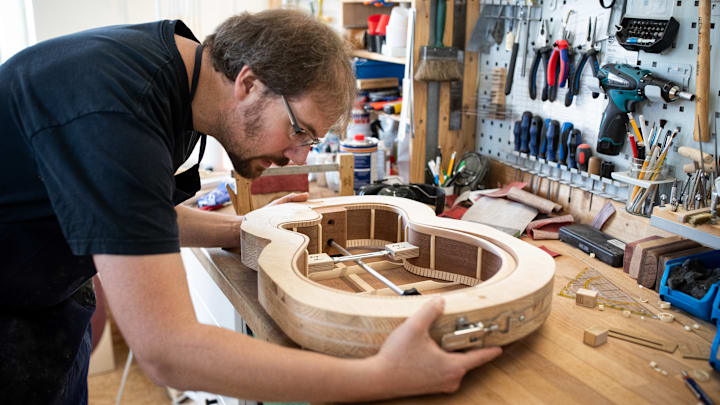As any guitar player will tell you, the topic of which wood sounds the best will start a heated debate with even the most relaxed players. But what difference do the different woods make, and which one is the best?
The Role of Wood in Guitar Construction
Manufacturers carefully choose the woods they use in the construction of their guitars for their tonal properties and aesthetic appeal. They might use different kinds in different parts of a guitar, including the body, neck, and fretboard, and these woods, along with the manufacturing process and design of the guitar, can dramatically affect the final tone and playability of the instrument.
Common Body Woods
Mahogany
Mahogany has a warm, rich, balanced tone and tends to vibrate nicely, allowing guitarists to sustain their notes longer. Its tone and durability make it popular in electric and acoustic guitars.
Alder
Alder is another wood with a balanced tone with a slight boost in the upper midrange frequencies. It’s not as common as mahogany, but it was a popular wood used in older Fender electric guitars, and Gibson even used it in a few models.
Ash
Ash is another popular vintage instrument wood that guitarists love for its bright, clear tones with a well-defined midrange. Two main types include swamp ash, which has a punchy tone, and northern ash, which is more robust.
Spruce
Spruce is the most common top wood that manufacturers use on acoustic guitars. It offers a broad dynamic range and crisp articulation.
Cedar
Cedar is another common acoustic wood that has a softer tone than spruce, making it a popular choice for fingerstyle players.
Common Neck Woods
Maple
Maple necks have a bright and snappy sound that many guitarists love, and the hardwood can take a lot of wear before it starts to break down.
Mahogany
Many manufacturers like to use mahogany for the necks thanks to its warmer tones and smooth feel. You will also frequently see it paired with a maple cap to help balance out the tone.
Common Fretboard Woods
Rosewood
Rosewood has a smooth feel and rich overtones that provide players with a rounded sound.
Ebony
Ebony fretboards offer guitarists a bright, crisp attack with a smooth, fast feel. These fretboards are perfect for complex and intricate music but lack sustain.
Why Does Wood Have Such an Impact on the Sound of a Guitar?
- The tone that a certain wood provides a guitar player depends on several factors, including its density, grain structure, and elasticity.
- Denser woods tend to produce more sustain and a warmer tone, while less dense woods usually result in a brighter, more resonant sound.
- More elastic woods, like spruce used in acoustic guitar tops, can vibrate more freely, producing a louder and more dynamic sound.
- Tight, straight grains usually promote consistent vibration patterns, resulting in a clear and focused tone, while irregular grain patterns can diffuse vibrations, leading to a more complex sound.
Follo GeekSided to learn more about Tonewood and to leave comments and questions.
